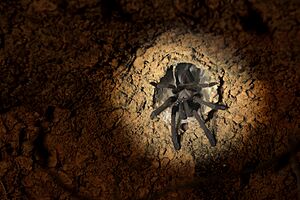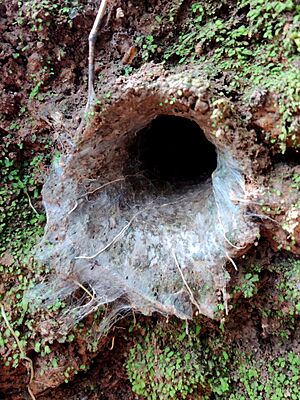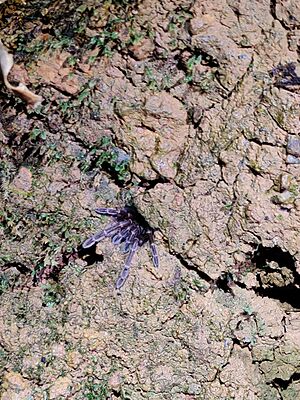Karwar large burrowing spider facts for kids
Quick facts for kids Karwar large burrowing spider |
|
|---|---|
 |
|
| Individual inside its burrow from Uttara Kannada, Karnataka. | |
| Conservation status | |
| Scientific classification |
The Thrigmopoeus truculentus is a type of Indian tarantula. It lives in the Western Ghats region. People also call it the Karwar large burrowing spider, Karwar burrowing spider, or lesser Goa mustard tarantula.
Contents
Where it Lives (Range)
This tarantula is only found in the Western Ghats of India. Specifically, you can find it in Karnataka, Goa, and Maharashtra. It has been seen on the sides of roads and trekking paths in places like Coorg.
Home and Lifestyle (Habitat and Ecology)
Thrigmopoeus truculentus spiders dig their homes, called burrows, in the ground. These burrows are often found on vertical banks, from about half a meter to five meters high. You can see them in areas like Coorg and Uttara Kannada districts.
During the Monsoon season and right after, these banks are usually covered with ferns and grasses. The tarantulas prefer to dig their burrows in shady spots. This means places with lots of trees overhead or in hilly areas where direct sunlight is not too strong.
The entrance to a T. truculentus burrow often looks like a trumpet or bell. The spider uses wet mud and its own spider silk to make the rim strong. Sometimes, the entrance has a small "porch" built from the extended top edge of the burrow. The spider also uses nearby twigs, dry leaves, and other bits of nature to make the entrance even stronger. This helps stop the burrow from collapsing. These extra bits also create a longer path for the spider to go in and out. The areas where these spiders dig their burrows are usually full of plants. In the rainy season, the area is very green, but it becomes less green after the monsoon.
Pet Trade
Some people like to keep Thrigmopoeus truculentus as a pet. However, it is not as popular as other types of tarantulas. Most buyers come from countries like the United Kingdom, the US, Germany, and Poland.
The demand for tarantulas as pets has grown a lot. This has led to more illegal trade and efforts to breed them in captivity. Sometimes, local people are hired to collect these spiders from the wild. Then, the spiders are illegally moved to breeders or collectors.
Threats to its Survival
The Thrigmopoeus truculentus faces several dangers. Its home is getting broken up and damaged. This is due to things like soil erosion and human activities. For example, roads are being made wider, which destroys the banks where these tarantulas build their burrows. Cutting down trees, soil erosion, and tourism also harm their habitat.
In 2008, this tarantula was almost listed as "vulnerable" on the IUCN Red List of Threatened Animals. But because its living areas are still shrinking and the quality of its habitat is getting worse, its population is declining. Because of this, T. truculentus is now listed as a Near-threatened species. This means it could become endangered soon if things do not change.




